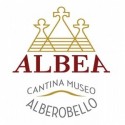 View larger
View larger More info
Red wine •Lui Magnum •Albea •LT1.5 x 01
monovitigno dry red wine - IGP Puglia - ingredients: nero di troia - manufacturer: Albea

info about producer: Albea
Albea Cantina Museo, Alberobello, Bari, Puglia, Italy.
The Cantina Albea is one of the most ancient, and recognized, wineries of the area, having succeeded in implementing modern production techniques within a historical framework and context.
The winery was founded at the turn of the last century and is entirely built of stone, with tanks designed to hold the wine carved out of the rock itself.
The Museum of Wine in Alberobello, originally the idea of Cavaliere Dante Renzini when he took over this historic winery, pays tribute to the agricultural and viticultural history and traditions of the area, as well as the rest of Puglia. The museum is located in the ample rooms on the top floor of the winery:
an integral part of the building, which is an interesting example of early 20th century industrial design. The extensive collection of ancient agricultural tools include those of a type which would have been in use from pre-Christian times until relatively recently. These, along with a collection of photographs and information boards, lead the visitor on a journey through time, learning how wine making techniques have evolved into the rather more sophisticated and refined ones found in use today. The museum is open to children and adults, but also to the elderly who recognize the tools and trappings of their past way of life, when the work of pruning the vines, harvesting the grapes, producing the wine and looking after the land required enormous physical effort, not always rewarded with a satisfactory outcome.
COMMUNICATIONS
FROM THE OUR TEAM:
(**) We ship regularly; delivery time depends on the destination.
(***) We are updating our catalog, several product's sheets and categories may be empty. Please contact us if you need info about ingredients and product's facts.


